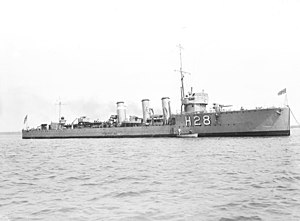 Sister ship HMS Orpheus in 1918
| |
| History | |
|---|---|
| Name | HMS Oberon |
| Ordered | February 1915 |
| Builder | Doxford, Sunderland |
| Launched | 29 September 1916 |
| Completed | December 1916 |
| Out of service | 9 May 1921 |
| Fate | Sold to be broken up |
| General characteristics | |
| Class and type | Admiralty M-class destroyer |
| Displacement | |
| Length | 265 ft (81 m) (p.p.) |
| Beam | 26 ft 9 in (8 m) |
| Draught | 16 ft 3 in (5 m) |
| Installed power | 3 Yarrow boilers, 25,000 shp (19,000 kW) |
| Propulsion | Brown-Curtis steam turbines, 3 shafts |
| Speed | 34 knots (63.0 km/h; 39.1 mph) |
| Range | 3,450 nmi (6,390 km; 3,970 mi) at 15 kn (28 km/h; 17 mph) |
| Complement | 76 |
| Armament |
|
HMS Oberon was a Repeat Admiralty M-class destroyer which served in the Royal Navy during the First World War. The M class were an improvement on the previous L-class, capable of higher speed. The vessel was launched in 1916 and joined the Grand Fleet. Oberon joined the Thirteenth Destroyer Flotilla which, in 1917, participated in a large anti-submarine warfare operation in the North Sea. The sortie led to three German submarines being sunk, although Oberon was not directly involved in these attacks. In 1918, the flotilla was involved in one of the final sorties of the Grand Fleet, but again the destroyer saw no action at the time. After the Armistice that marked the end of the First World War, Oberon was placed in reserve, decommissioned and, in 1921, sold to be broken up.